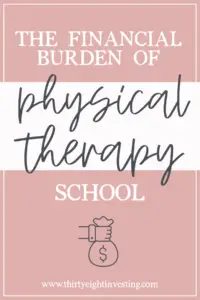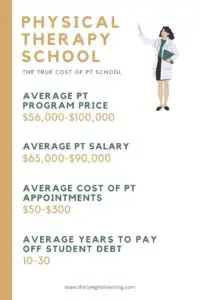Disclosure: This post contains affiliate links. If you click through a link and make a purchase, it will earn me a small commission, at no additional cost to you! See our disclaimer for details.
The Cost of Physical Therapy School in America
As most of my readers know, I am a licensed Doctor of Physical Therapy by trade and a blogger on the side.
Whether you are interested in the health professions or not, this article will help you better understand student debt and the importance for any student to pay off loans quickly!
The field of physical therapy is rapidly growing, and for a good reason. Yet, did you know that new PT graduates enter the workforce with entry-level salaries that are significantly lower than what the general public perceives.
Physical therapist programs, according to the 2020 vision of the APTA, will all be Doctorate programs. This means graduating students will all have a DPT after their name, indicating they are Doctors of Physical Therapy.
For those of you who don’t know, physical therapists can work in many settings, including hospitals, pediatric clinics, and outpatient facilities. Salaries range, and there are opportunities for specializations and certifications.
The prestige is great, when adding a title such as “doctor” within a name, but is this health profession worth it?
There are numerous other health professions out there, such as a DNP (Doctor of Nursing Practice), Dentist, Medical Doctor, and Optometrist, that all have doctorate-level degrees, yet the pay is much higher than for PT’s.
And another important factor of all of this: the years of school required.
For a health field with 7 years of schooling (4 undergraduate + 3 graduate), assuming the student gets in the program the first year they apply, and for a clinical doctorate, the starting salary of $65,000 is extremely surprising!
With all of this said, now consider paying off all the student debt.
In this article we will explore:
- Current salaries for PT’s across America and the overall cost of education (as of 2020)
- Debt payoff expectations
- The PT Bubble Phenomenon
- Pros and Cons of this field
come Check Out What’s New!
- 10 Huge Money Mistakes To Avoid in Your 20’s
- 4 Critical Tips to Graduating Debt Free
- The Only 10 Books You Must Read To Retire Early
The Physical Therapy School Process
Acceptance into a PT program requires a Bachelor’s degree. This means the student will already have to attend approximately 4 years of schooling before entering their graduate program.
In short, the cost of attending a physical therapy program has increased 100% for private institutions and 50% for public universities over the past decade. That equates to almost $100,000 to attend a private physical therapy program, and $56,000 for a PT program at a public college!
This is leading to students graduating with approximately $96,000 of student loan debt (cumulative).
As we will discuss later in this article, salaries have not gone up, even though program costs continue to skyrocket.
However, with physical therapy growing so much in the health industry, it is attracting even more students to apply.
Physical therapy program attendance is expected to grow 34% from 2014-2024 which is more than the average for all career paths.
You’d think this would equate to an increase in salary, right? Not so much.
The PT’s Salary
This is the main reason I chose to write an entire article about PT school debt: our salary.
According to ZipRecruiter, physical therapists don’t have competitive pay in comparison to other doctorate-level health professionals.
The average salary for a physical therapist in America ranges anywhere from $90,000 ($43 an hour) in New York to $65,000 ($31 an hour) in North Carolina!
Keep in mind the word “average”. There will always be situations where people work part-time, work PRN (meaning: as needed), or may be in a specialized clinic with multiple certifications or a specialization.
If you have ever had physical therapy, you probably have thought that, considering appointments cost so much, that us PT’s are making bank!
Did you know that physical therapy appointments without insurance, or out of pocket, can cost anywhere from $50-$300!
The Physical Therapy Bubble Phenomenon:
Now that we’ve discussed physical therapy education and salaries, we need to look at the phenomenon that may interest some soon-to-be PT students.
The cost of PT programs are increasing while salaries seem to be creeping up alongside inflation. Although there is a greater need for physical therapists, PTs aren’t being compensated more.
What ever happened to supply and demand?
The Bubble Phenomenon goes like this: tuition will keep going up until it becomes nearly impossible to realistically pay it off due to low earnings. The “bubble” would burst when the “ratio of debt to earning potential increases to a tipping point”.
Student Debt
It’s almost hard to find a person 30 years old and under that does not have student debt! If you follow my Instagram, you’d know that I still and fighting off loans from my physical therapy education!
Like any other debt, it is a liability and it only will continue to take money from you until you pay it off!
Something interesting to consider: approximately 54% of people with student loans did not consider their future monthly payments before taking out loans!
That is a scary fact.
With this in mind, let’s take a look at student debt repayment:
It is assumed that the average DPT student will have some undergraduate student debt, along with their graduate student loans. If the student needs additional money for living or for expenses/semesters where loans are not offered (ex. summer semesters), then they can receive PLUS loans, which are at a higher interest rate.
The average interest rate for these loans (as of 2019) are as follows:
- Undergraduate: 4.81%
- Graduate: 6.38%
- PLUS: 7.44%
Let’s Calculate!
Calculate your loan payback here!
We’ll start with some “low” examples:
- $40,000 debt by graduation | 6.6% loan interest rate | 10 years
- 119 payments of $456.23
- Interest accrued: $14,747.56
- Total Paid: $54,747.56
- Budget a minimum of 10% of your gross income to loans
- $40,000 debt by graduation | 6.6% loan interest rate | 20 years
- 239 payments of $300.59
- Interest accrued: $32,141.02
- Total Paid: $72, 141.02
- Budget a minimum of 15% of your gross income to loans
private schools and students with high debt:
- $100,000 debt by graduation | 6.8% loan interest rate (average) | 10 years
- 239 payments of $1,150.80
- Interest accrued: $38,096.57
- Total Paid: $138,096.57
- Should have minimum salary of $92K to pay this off in 10 years if budgeting 15% of gross income
- $100,000 debt by graduation | 6.8% loan interest rate (average) | 20 years
- 239 payments of $763.34
- Interest accrued: $83,201.36
- Should have minimum salary of $91K to pay this loan off in 20 years if budgeting 10% of income.
Get a step ahead of your student debt by learning about your net worth!
Why You Should Still Consider Physical Therapy School
In case you stumbled upon this article through Pinterest or Google, I hope it is not a deterrent to entering the career of your dreams.
This is in no way intended to make anyone less interested in the field. In fact, I hope it brings more of my readers to see this profession in a new light!
If you are considering this profession, and have looked through your student loan potential, do read through the following reasons to help your potential to pay off your loans sooner:
- There is opportunity to specialize and earn certifications to increase your earning potential
- Working PRN offers the opportunity to earn-per-hour at a higher rate than salaried workers
- Different settings, such as a hospital, may pay more than general outpatient facilities
- Working as a Travel PT provides the opportunity to earn a higher salary
- Owning your own practice or managing one could significantly increase your take-home pay
- Creating a social platform (blog, YouTube, Facebook community, etc.) could earn you a side income by providing your specific knowledge and expertise to help others
Let’s Summarize!
- The student loan debt to become a physical therapist is higher than what the general public may think! Additionally, their salaries may not be competitive enough to pay off the loans very quickly.
- No matter your career choice or choice of major, it is imperative to consider what your monthly payments will be, before accepting student loans!
Were you aware of the debt that physical therapists accrue?
___
References:
- Jette, and Diane U. “Physical Therapist Student Loan Debt.” OUP Academic, Oxford University Press, 1 Nov. 2016, academic.oup.com/ptj/article/96/11/1685/2870027.
- Koria, Keith. “Financial Literacy and the New DPT Grad.” APTA, Feb. 2017, www.apta.org/PTinMotion/2017/2/Feature/FinancialLiteracy/.
- https://www.credible.com/blog/refinance-student-loans/what-are-average-student-loan-interest-rates/
- https://www.ziprecruiter.com/Salaries/What-Is-the-Average-Physical-Therapist-Salary-by-State
- Lusardi A, Scheresburg C, Oggero N. Student loan debt in the US: An analysis of the 2015 NFCS data. Global Financial Literacy Excellence Center policy brief. November 2016.



